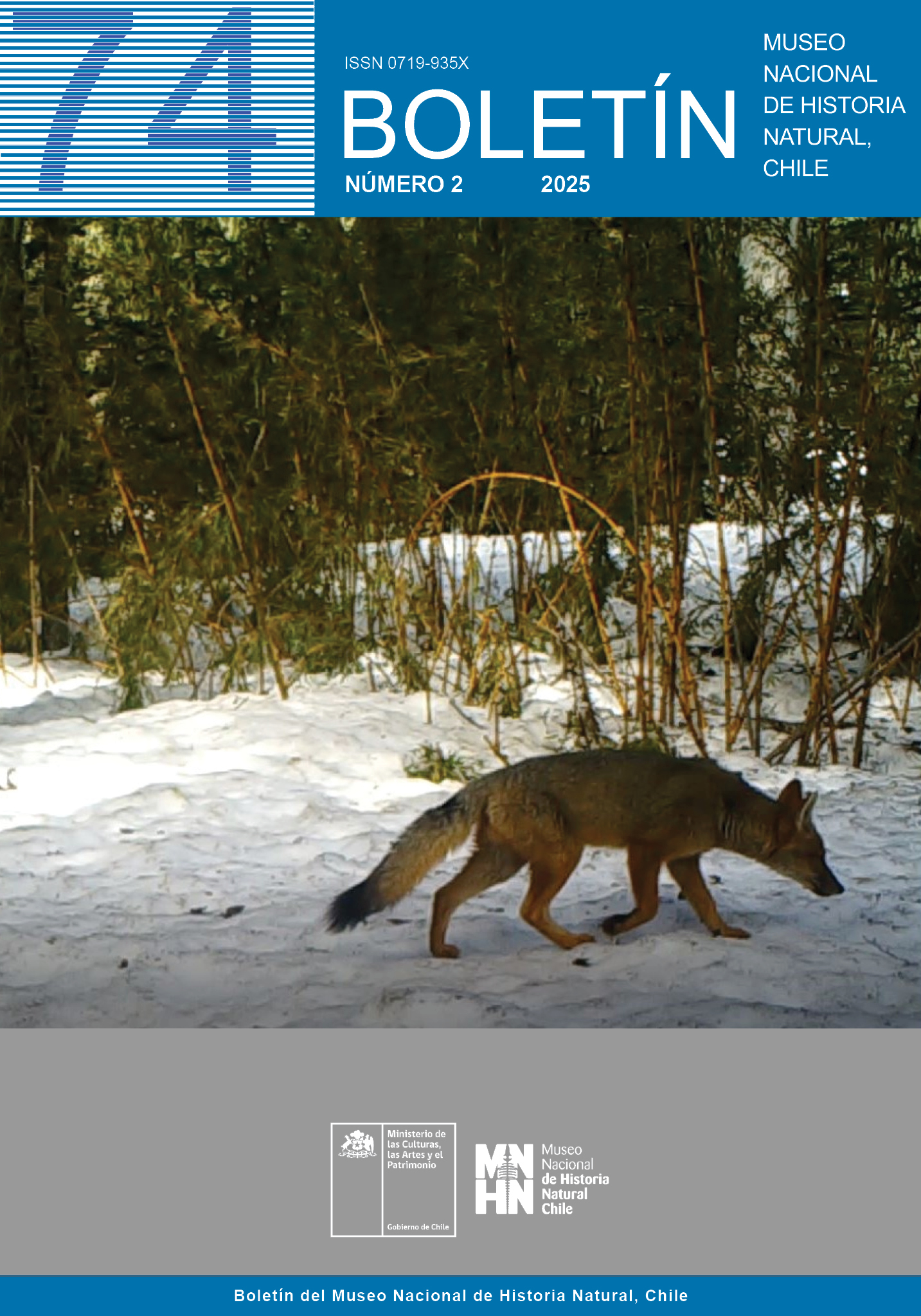Diversity and abundance of mesomammals in a Monkey puzzle tree (Araucaria araucana) forest in Villarrica National Park, Araucanía region, Chile
DOI:
https://doi.org/10.54830/bmnhn.v74.n2.2025.963Keywords:
abundancia, Araucaria araucana, Cervus elaphus, diversidad, Lepus europaeus, Puma concolor, Shannon-Wiener, Sus scrofaAbstract
The Monkey puzzle tree (Araucaria araucana) forests at Puesco area of Villarrica National Park, Chile, harbors both native and non-native mesomammals. However, the relative abundance and diversity of these species have remained understudied, and potential variations due to seasonal or annual changes are still not well understood. This study aims to fill this knowledge gap, providing insight into species interactions and environmental dynamics within this unique ecosystem, with the broader goal of supporting effective biodiversity conservation and management strategies in the park. The diversity and relative abundance of mesomammals in an Araucaria araucana forest within Villarrica National Park were estimated and analyzed. Data was collected through camera trapping at ten locations over a period of 26 months. The cameras were randomly placed in the field, maintaining a minimum distance of 1200 meters between them, covering an area of approximately 3500 hectares. Records were analyzed by grouping data from spring of one year to the following spring, calculating the relative abundance index and diversity indices. Five mesomammal species were detected: Puma concolor (puma), Lycalopex spp (gray or culpeo foxes), Lepus europaeus (European hare), Sus scrofa (wild boar), and Cervus elaphus (red deer). Clear annual and seasonal differences were observed in the relative abundance index. Alarmingly, the relative abundance of non-native mesomammals was ten times higher than that of native species. Diversity (H’) throughout the entire period was low, with significant differences discernible between years and seasons. Although data on the population abundance of invasive species in Chile are scarce, this study reveals a high relative abundance of non-native species in an Araucaria forest. Coupled with the observed low diversity, this is a cause for concern, especially considering the presence of an endangered endemic species like A. araucana. Significant differences in abundance were found only for Sus scrofa and Lycalopex spp. over the study period. Alpha diversity for the entire study period was low, with differences observed both between years and seasons. In conclusion, this study highlights the urgent need for reflection and action regarding the dominance of exotic species in a sector of a protected area. The findings can serve as a basis for future research and guide conservation efforts. These results underscore the urgent need for targeted strategies to manage the high abundance of non-native species and improve of Villarrica National Park.
Downloads
References
ALHO, C. J. 2008. The value of biodiversity. Braz J Biol, 68(4 Suppl), 1115-1118. https://doi.org/10.1590/s1519-69842008000500018
BALLARI, S. A., L.F. LA SALA, M.L. MERINO, B. CARPINETTI, M. WINTER, R.E. GÜRTLER, S. BARANDARIAN, M.F. CUEVAS, W.E. CONDORI, A. TAMMONE, A. MARCOS y M.N. BARRIOS-GARCIA. 2024. El jabalí y el cerdo silvestre (Sus scrofa) en la Argentina. Ecología Austral, 401-421. https://doi.org/10.25260/ea.24.34.2.0.2389
BROGI, R., R. CHIRICHELLA, F. BRIVIO, E. MERLI, E. BOTTERO y M. APOLLONIO. 2021. Capital-income breeding in wild boar: a comparison between two sexes. Scientific Reports, 11(1). https://doi.org/10.1038/s41598-021-84035-w
BROGI, R., S. GRIGNOLIO, F. BRIVIO y M. APOLLONIO. 2020. Protected areas as refuges for pest species? The case of wild boar. Global Ecology and Conservation, 22, e00969. https://doi.org/10.1016/j.gecco.2020.e00969
CONAF. 2013. Plan de manejo Parque nacional Villarrica. Temuco, Chile Retrieved from https://www.bienesnacionales.cl/wp-content/uploads/2017/10/LIC_VILLARICA_ANEXO_10.pdf
CONFORTI, P.A. y C.E. LUPANO. 2011. Selected Properties of Araucaria angustifolia and Araucaria araucana Seed Protein. International Journal of Food Properties, 14(1), 84-91. https://doi.org/10.1080/10942910903131431
CORTÉS-MARCIAL, M. y M. BRIONES-SALAS. 2014. Diversidad, abundancia relativa y patrones de actividad de mamíferos medianos y grandes en una selva seca del Istmo de Tehuantepec, Oaxaca, México. Revista de Biología Tropical, 62(4), 1433. https://doi.org/10.15517/rbt.v62i4.13285
DI RENZO J.A., M.G. BALZARINI, I. GONZÁLEZ, M. TABLADA y C.V. ROBLEDO. 2020. InfoStat. Universidad Nacional de Córdoba. http://www.infostat.com.ar
DONOSO-ZEGERS, C. 1993. Bosques templados de Chile y Argentina. Variación, estructura y dinámica. Ecología Forestal. Editorial Universitaria. https://bibliotecadigital.infor.cl/handle/20.500.12220/5116
FLUECK, W. T. y J.A.M. SMITH-FLUECK. 2012. A review of introduced cervids in Chile. Animal Production Science, 52(8): 681-684. https://doi.org/10.1071/an11343
GAJARDO MICHELL, R. 1980. Vegetación del bosque de Araucaria araucana (Mol.) K. Koch en la cordillera de los Andes (Lonquimay, provincia de Malleco). Chloris Chilensis, 23(1), 26-50. http://www.chlorischile.cl/23-1-web/gajardo-araucaria.pdf
GASTWIRTH, J. L., Y.R. GEL y W. MIAO. 2009. The Impact of Levene’s Test of Equality of Variances on Statistical Theory and Practice. Statistical Science, 24(3): 343-360. https://doi.org/10.1214/09-sts301
GOBIERNO DE CHILE. 1990. Decreto Supremo N° 43: Declara Monumento Natural a la especie Araucaria araucana. Ministerio de Agricultura. Recuperado de https://www.fao.org/faolex/results/details/es/c/LEX-FAOC146791/
HENRÍQUEZ, C., B. ESCOBAR, F. FIGUEROLA, I. CHIFFELLE, H. SPEISKY y A.M. ESTÉVEZ. 2008. Characterization of piñon seed (Araucaria araucana (Mol) K. Koch) and the isolated starch from the seed. Food Chemistry, 107(2): 592-601. https://doi.org/10.1016/j.foodchem.2007.08.040
HERRMANN, T. M. 2005. Knowledge, values, uses and management of the Araucaria araucana forest by indigenous Mapuche Pewenche people: A basis for collaborative natural resource management in southern Chile. Natural Resources Forum, 29(2): 120-134. https://doi.org/10.1111/j.1477-8947.2005.00121.x
HOFFMANN, A., J. DECHER, F. ROVERO, J. SCHAER, G. VOIGT y G. WIBBELT. 2010. Field Methods and Techniques for Monitoring Mammals. In J. Eymann, J. Degreef, C. Häuser, J. C. Monje, Y. Samyn, y D. VandenSpiegel (Eds.), Manual on field recording techniques and protocols for All Taxa Biodiversity Inventories and Monitoring (Vol. 8). Abctaxa. http://www.abctaxa.be/volumes/volume-8-manual-atbi
HUTCHESON, K. 1970. A test for comparing diversities based on de Shannon formula. Journal of theoretical biology, 29(1): 151-154. https://doi.org/10.1016/0022-5193(70)90124-4
INTERNATIONAL UNION FOR CONSERVATION OF NATURE’S (IUCN). 2024. The IUCN Red List of threatened species. Version 2024-1. URL: iucnredlist.org.
JACOBS, C.E. y D.E. AUSBAND. 2018. An evaluation of camera trap performance – What are we missing and does deployment height matter? Remote Sensing in Ecology and Conservation, 4(4): 352-360. https://doi.org/10.1002/rse2.81
JAKSIC, F. M. y S.A. CASTRO. 2021. Biological Invasions in the South American Anthropocene: Global Causes and Local Impacts. Springer.
JENKS, K. E., P. CHANTEAP, D. KANDA, C. PETER, P. CUTTER, T. REDFORD, J.L. ANTONY, J. HOWARD y P. LEIMGRUBER. 2011. Using Relative Abundance Indices from Camera-Trapping to Test Wildlife Conservation Hypotheses – An Example from Khao Yai National Park, Thailand. Tropical Conservation Science, 4(2): 113-131. https://doi.org/10.1177/194008291100400203
JAKSIC, F. M., J.A. IRIARTE, J.E. JIMÉNEZ, y D.R. MARTÍNEZ, D. R. 2002. Invaders without frontiers: Cross-border invasions of exotic mammals. Biological Invasions, 4(1): 157–173. https://doi.org/10.1023/A:1020576709964
KROPIL, R. P. SMOLKO y P. GARAJ. 2015. Home range and migration patterns of male red deer Cervus elaphus in Western Carpathians. European Journal of Wildlife Research, 61(1): 63-72. https://doi.org/10.1007/s10344-014-0874-4
LAPIDGE, S, W. JASON, S. MICHELLE y S. LINTON. 2009. Is America ready for a humane feral pig ‘toxin’?.
LASALA, L. F., J.M. BURGOS, N.C. CARUSO, C.E. BAGNATO, S.A. BALLARI, D.L GUADAGNIN, A. KINDEL, M. ETGES, M.L. MERINO, A. MARCOS, O. SKEWES, D. SCHETTINO, A.M. PEREZ, E. CONDORI, A. TAMMONE, B. CARPINETTI y S.M. ZALBA. 2023. Wild pigs and their widespread threat to biodiversity conservation in South America. Journal for Nature Conservation, 73. https://doi.org/https://doi.org/10.1016/j.jnc.2023.126393
DIARIO OFICIAL DE CHILE 1996. Ley No. 19.473, Título II, art. 7º. Recuperado de https://www.bcn.cl/leychile/navegar?idNorma=30840yidParte=8782319
LITTLEWOOD, N. A., M.H. HANCOCK, S. NEWEY, G. SHACKELFORD y R. TONEY. 2021. Use of a novel camera trapping approach to measure small mammal responses to peatland restoration. European Journal of Wildlife Research, 67(1). https://doi.org/10.1007/s10344-020-01449-z
LIU, X., P. WU, M. SONGER, Q. CAI, X. HE, Y. ZHU y X. SHAO. 2013. Monitoring wildlife abundance and diversity with infra-red camera traps in Guanyinshan Nature Reserve of Shaanxi Province, China. Ecological Indicators, 33: 121-128. https://doi.org/10.1016/j.ecolind.2012.09.022
MAMUIL MALAL, E. M. 2022. Lluvia diaria 2012-2019. Autoridad Interjurisdiccional de Cuencas (AIC) de los ríos Limay, Neuquén y Negro. Retrieved 10 octubre 2022 from http://www.aic.gov.ar/sitio/estaciones-detalle?a=74yz=736876849
MARKOV, N., N. PANKOVA y K. MORELLE. 2019. Where winter rules: Modeling wild boar distribution in its north-eastern range. Sci Total Environ, 687(15), 1055-1064. https://doi.org/10.1016/j.scitotenv.2019.06.157
MENZIES, A. K., E.K. STUDD, Y.N. MAJCHRZAK, M.J.L. PEERS, S. BOUTIN, B. DANTZER, J.E. LANE, A.G. MCADAM, M.M. HUMPHRIES y C. WHITE. 2020. Body temperature, heart rate, and activity patterns of two boreal homeotherms in winter: Homeostasis, allostasis, and ecological coexistence. Functional Ecology, 34(11): 2292-2301. https://doi.org/10.1111/1365-2435.13640
MINISTERIO DEL MEDIO AMBIENTE. 2019a. Araucaria araucana ((Molina) K. Koch). Ficha de clasificación. Recuperado de https://clasificacionespecies.mma.gob.cl/wp-content/uploads/2019/10/Araucaria_araucana_14RCE_FINAL.pdf
MINISTERIO DEL MEDIO AMBIENTE. 2019b. Lama guanicoe. Recuperado de https://clasificacionespecies.mma.gob.cl/wp-content/uploads/2019/10/Lama_guanicoe_P05R7-9_RCE.pdf
MORENO, C. E. 2001. Métodos para medir la biodiversidad (Vol. 1). MyT–Manuales y Tesis SEA. https://www.researchgate.net/publication/304346666_Metodos_para_medir_la_biodiversidad
MORENO, C.E., F. BARRAGÁN, E. PINEDA y N.P. PAVÓN. 2011. Reanálisis de la diversidad alfa: alternativas para interpretar y comparar información sobre comunidades ecológicas. Revista Mexicana de Biodiversidad, 82(4): 1249-1261. https://doi.org/10.22201/ib.20078706e.2011.4.745
MOSQUERA-GUERRA, F., F. TRUJILLO, A.P. DÍAZ-PULIDO y H. MANTILLA-MELUK. 2018. Diversidad, abundancia relativa y patrones de actividad de los mamíferos medianos y grandes, asociados a los bosques riparios del río Bita, Vichada, Colombia. Biota Colombiana, 19(1): 202-218. https://doi.org/10.21068/c2018v19n01a13
NIEMINEN, P. y A.M. MUSTONEN. 2008. A preliminary study on the seasonal body temperature rhythms of the captive mountain hare (Lepus timidus). Cryobiology, 56(2): 163-167. https://doi.org/10.1016/j.cryobiol.2008.01.004
PARKER, I. M., D. SIMBERLOFF, W.M. LONSDALE, K. GOODELL, M. WONHAM, P.M. KAREIVA, M.H. WILLIAMSON, B. VON HOLLE, P.B. MOYLE, J.E. BYERS y L. GOLDWASSER. 1999. Impact: toward a framewor for understanding the ecological efects of invaders. Biological Invasions, 1(1): 3-19. https://doi.org/10.1023/a:1010034312781
PELLIZA-SBRILLER, A., y L. BORRELLI. 2008. Observaciones sobre la dieta del jabalí en Neuquén. Presencia, 52, 28-30
PIELOU, E.C. 1975. Ecological Diversity (Vol. 1). Wiley-Interscience. https://doi.org/https://doi.org/10.4319/lo.1977.22.1.0174b
REAL ACADEMIA ESPAÑOLA. 2022. Meso. Asociación de Academias de la Lengua Española. https://dle.rae.es/meso-
REIS, M.S.D., A. LADIO y N. PERONI. 2014. Landscapes with Araucaria in South America: evidence for a cultural dimension. Ecology and Society, 19(2). https://doi.org/10.5751/es-06163-190243
SÁNCHEZ PORRAS, R., Y. MEJÍAS VÁSQUEZ, K. CHAVARRÍA ESQUIVEL y L. BRENES CAMBRONERO. 2019. Diversidad y patrones de actividad de mamíferos medianos y grandes, en la Reserva Biológica Alberto Manuel Brenes, Alajuela, Costa Rica. Pensamiento Actual, 19(33): 175-189. https://doi.org/10.15517/pa.v19i33.39619
SANGUINETTI, J. 2018. Guía para la elaboración de planes de manejo del Jabalí (Sus scrofa) dentro de la Administración de Parques Nacionales (Argentina).
SANGUINETTI, J., R.S. DITGEN, S.R. DONOSO-CALDERÓN, M.A. HADAD, L. GALLO, M.E. GONZÁLEZ, J.T. IBARRA, A. LADIO, S.A. LAMBERTUCCI, P. MARCHELLI, I.A. MUNDO, M.A. NUÑEZ, A. PAUCHARD, P. PUCHI, M.A. RELVA, O. SKEWES, J.D. SHEPHERD, K. SPEZIALE, M.L. VÉLEZ, M.E. SALGADO y C. ZAMORANO-ELGUETA. 2023. Información científica clave para la gestión y conservación del ecosistema biocultural del Pewén en Chile y Argentina. Bosque (Valdivia), 44(1): 179-190. https://doi.org/10.4067/s0717-92002023000100179
SANGUINETTI, J. y T. KITZBERGER, T. 2010. Factors controlling seed predation by rodents and non-native Sus scrofa in Araucaria araucana forests: potential effects on seedling establishment. Biological Invasions, 12(3): 689-706. https://doi.org/10.1007/s10530-009-9474-8
SEPÚLVEDA-SÁNCHEZ, F.J. y O. SKEWES. 2018. Mesomamíferos en la Reserva Nacional Nonguén: antecedentes de una reserva reciente y cercana a una gran ciudad, Concepción, Chile. Biodiversidata(3), 45-50. https://www.parquesnacionales.cl/documento/mesomamiferos-en-la-reserva-nacional-nonguen-antecedentes-de-una-reserva-reciente-y-cercana-a-una-gran-ciudad-concepcion-chile/
SERVICIO DE EVALUACIÓN MEDIOAMBIENTAL. 2013. Informe consolidado de la evaluación del estudio de impacto ambiental del proyecto “Mejoramiento Ruta 199-CH, sector Puesco-Paso Mamuil Malal, Región de la Araucanía”. Recuperado de https://infofirma.sea.gob.cl/DocumentosSEA/MostrarDocumento?docId=19/5d/88356c7f5fb92113d68458b559c7190547cf
SHEPHERD, J.D. y R.S. DITGEN. 2005. Human use and small mammal communities of Araucaria forests in Neuquén, Argentina. Mastozoología Neotropical, 12(2): 217-226. http://www.scielo.org.ar/scielo.php?script=sci_arttextypid=S0327-93832005000200008
SILVA-MARTÍNEZ, J. S. 2009. Estructura y composición de los bosques de Araucaria-Nothofagus en la Reserva Nacional Malalcahuello, posterior a su explotación selectiva Universidad Austral de Chile]. Valdivia, Chile. https://bibliotecadigital.infor.cl/handle/20.500.12220/17343
SKEWES, O. y F.M. JAKSIC. 2015. History of the introduction and present distribution of the european wild boar (Sus scrofa) in Chile. Mastozoología Neotropical, 22(1): 113-124. http://www.scielo.org.ar/scielo.php?script=sci_arttextypid=S0327-93832015000100012.
SKEWES, O., A. KAMBAS, P. GÄDICKE y O. KEULING. 2025. First wild boar density data from Araucaria forest in Patagonian Andes. PeerJ, 13, e18951. https://doi.org/10.7717/peerj.18951
VEBLEN, T. T., T. KITZBERGER, T. y R. VILLALBA. 2004. Nuevos paradigmas en ecología y su influencia sobre el conocimiento de la dinámica de los bosques del sur de Argentina y Chile. Editorial de la Universidad de La Plata. https://www.uv.mx/personal/tcarmona/files/2010/08/veblen-et-al-.pdf
ZILLER, S. R., M.D.S. DECHOUM, R.A.D. SILVEIRA, H.M. DA ROSA, M.S. MOTTA, L.F. DA SILVA, B.C.M. OLIVEIRA y R.D. ZENNI. 2020. A priority-setting scheme for the management of invasive non-native species in protected areas. NeoBiota, 62: 591-606. https://doi.org/10.3897/neobiota.62.52633
Downloads
Published
How to Cite
Issue
Section
License
Copyright (c) 2025 Javiera Calvo Rebolledo, Oscar Skewes

This work is licensed under a Creative Commons Attribution-NonCommercial-NoDerivatives 4.0 International License.




